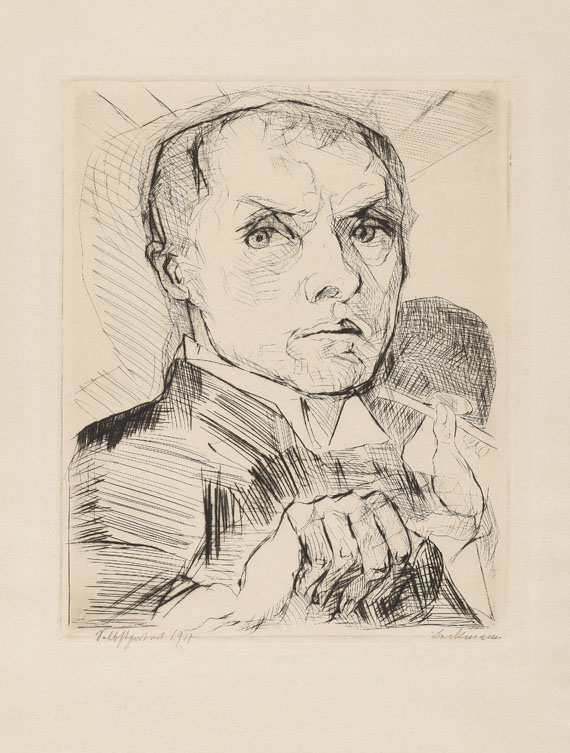345
Max Beckmann
Selbstbildnis mit Griffel, 1917.
Drypoint
Estimate:
€ 18,000 / $ 19,260 Sold:
€ 37,500 / $ 40,125 (incl. surcharge)
Selbstbildnis mit Griffel. 1917.
Drypoint.
Hofmaier 105 II Ba (of b). Signed, dated and inscribed "Selbstporträt". One of 40 copies before the plate was steeled. On light creme Japon. 29,6 x 23,4 cm (11,6 x 9,2 in). Sheet: 47,6 x 32,3 cm (18,8 x 12,7 in).
Sheet from the portfolio "Gesichter". The work was released as 13th print of the Mareés Gesellschaft (with blindstamp), by Verlag R. Piper & Co. Munich. [KD].
One of the artist's most important etchings in splendid impression.
In spite of his family's opposition, Beckmann managed to get their permission to become a painter after finishing school. He went to the Großherzogliche Kunstschule in Weimar from 1900 to 1903 where he studied mainly under the Norwegian landscape painter Carl Frithjof Smith. After his graduation and several trips to Paris, Geneva and Florence Beckmann settled in Berlin in 1907 where he joined the 'Berliner Sezession'. At the outbreak of the First World War Beckmann volunteered and served in East Prussia and Flanders.
With the success of the National Socialists the artist was increasingly defamed and finally dismissed from his teaching post. His works were removed from public collections in Germany. Political pressure forced him to emigrate to Holland in 1937. Here he was also restricted by the political situation, however, and an invitation to Saint Louis as a guest professor in 1947 was a welcome occasion to emigrate to the USA. This post at the Washington University School of Fine Arts was followed by teaching posts at the University of Colorado in Boulder in 1949, the Brooklyn Museum Art School in New York and Mills College in Oakland, California in the summer of 1950. Max Beckman died on 27 December 1950 in New York. Beckmann's early style is influenced by German Impressionism, particularly by Lovis Corinth. His experiences during the war led to a more Expressionist style close to the 'Neue Sachlichkeit'. Beginning in the 1920s, the individualism of his style expressed itself in his intense occupation with the object world, which is reflected in an Expressive, graphic structure. Beckmann's prevailing subject was the lonely, threatened man in an apocalyptic world. In his late work this view culminates in large symbolical and mythological triptychs. Max Beckmann was awarded the Carnegie Prize (1929), the first prize at the international 'Golden Gate' exhibition (1939) and the Conte-Volpi Prize at the XXV. Biennale in Venice (1950) as well as an honorary doctorate by Washington University in St. Louis.
Drypoint.
Hofmaier 105 II Ba (of b). Signed, dated and inscribed "Selbstporträt". One of 40 copies before the plate was steeled. On light creme Japon. 29,6 x 23,4 cm (11,6 x 9,2 in). Sheet: 47,6 x 32,3 cm (18,8 x 12,7 in).
Sheet from the portfolio "Gesichter". The work was released as 13th print of the Mareés Gesellschaft (with blindstamp), by Verlag R. Piper & Co. Munich. [KD].
One of the artist's most important etchings in splendid impression.
In spite of his family's opposition, Beckmann managed to get their permission to become a painter after finishing school. He went to the Großherzogliche Kunstschule in Weimar from 1900 to 1903 where he studied mainly under the Norwegian landscape painter Carl Frithjof Smith. After his graduation and several trips to Paris, Geneva and Florence Beckmann settled in Berlin in 1907 where he joined the 'Berliner Sezession'. At the outbreak of the First World War Beckmann volunteered and served in East Prussia and Flanders.
With the success of the National Socialists the artist was increasingly defamed and finally dismissed from his teaching post. His works were removed from public collections in Germany. Political pressure forced him to emigrate to Holland in 1937. Here he was also restricted by the political situation, however, and an invitation to Saint Louis as a guest professor in 1947 was a welcome occasion to emigrate to the USA. This post at the Washington University School of Fine Arts was followed by teaching posts at the University of Colorado in Boulder in 1949, the Brooklyn Museum Art School in New York and Mills College in Oakland, California in the summer of 1950. Max Beckman died on 27 December 1950 in New York. Beckmann's early style is influenced by German Impressionism, particularly by Lovis Corinth. His experiences during the war led to a more Expressionist style close to the 'Neue Sachlichkeit'. Beginning in the 1920s, the individualism of his style expressed itself in his intense occupation with the object world, which is reflected in an Expressive, graphic structure. Beckmann's prevailing subject was the lonely, threatened man in an apocalyptic world. In his late work this view culminates in large symbolical and mythological triptychs. Max Beckmann was awarded the Carnegie Prize (1929), the first prize at the international 'Golden Gate' exhibition (1939) and the Conte-Volpi Prize at the XXV. Biennale in Venice (1950) as well as an honorary doctorate by Washington University in St. Louis.
345
Max Beckmann
Selbstbildnis mit Griffel, 1917.
Drypoint
Estimate:
€ 18,000 / $ 19,260 Sold:
€ 37,500 / $ 40,125 (incl. surcharge)




 Lot 345
Lot 345 
